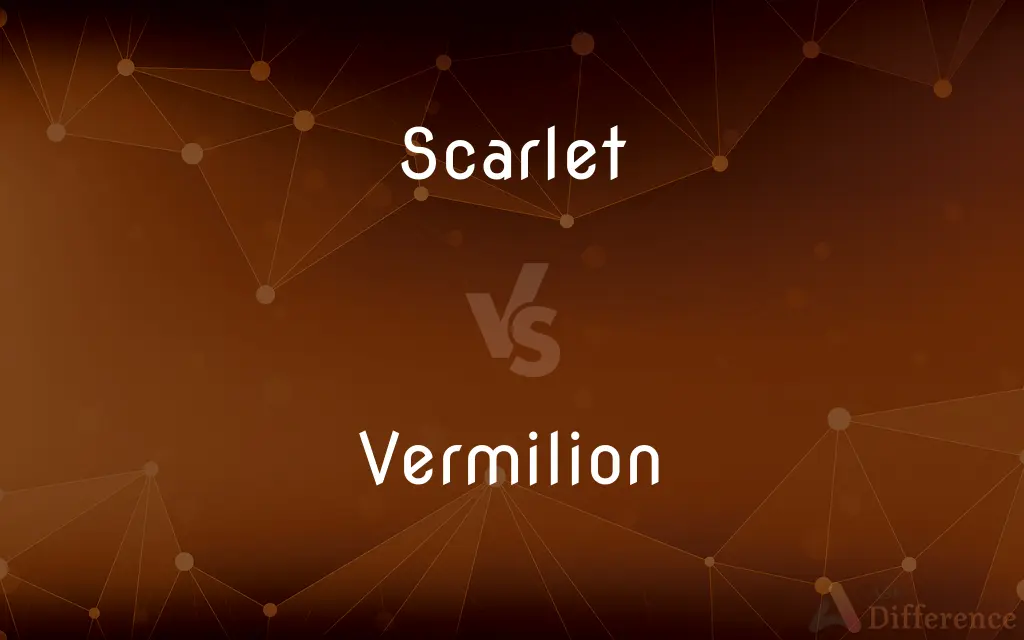Scarlet vs. Vermilion — What's the Difference?
By Fiza Rafique & Maham Liaqat — Updated on March 31, 2024
Scarlet is a bright red with a slight orange tint, often associated with luxury, while vermilion is a vivid red to reddish-orange pigment, traditionally used in art.

Difference Between Scarlet and Vermilion
Table of Contents
ADVERTISEMENT
Key Differences
Scarlet is a brilliant, vivid red color that has a hint of orange. It's commonly associated with passion, danger, and high energy. Vermilion, on the other hand, is a specific pigment that has been historically significant in art and decoration, offering a similar but distinctly more orange-red hue.
Scarlet is often linked with luxury, opulence, and prestige, used in fashion and ceremonial attire to denote status. Whereas vermilion, derived from cinnabar, has been prized for its striking color in fine arts, often symbolizing life, eternity, and immortality in different cultures.
In terms of symbolism, scarlet carries connotations of courage, strength, and love, frequently found in flags and emblems. Vermilion, however, has been used with sacred and protective connotations in various cultures, especially in China and India, where it holds spiritual significance.
The use of scarlet is widespread in the modern world, from fashion to branding, where it conveys boldness and visibility. Vermilion remains a choice for artists and designers seeking a specific hue for its historical richness and depth, especially in paintings and traditional arts.
Scarlet's origins can be traced back to the Middle Ages, named after the luxurious scarlet cloth. Vermilion, on the other hand, has origins in antiquity, used by the Romans and in ancient China, highlighting its enduring legacy in art and decoration.
ADVERTISEMENT
Comparison Chart
Hue
Bright red with a slight orange tint.
Vivid red to reddish-orange pigment.
Associated With
Luxury, passion, danger.
Art, immortality, spirituality.
Symbolism
Courage, strength, love.
Life, protection, sacredness.
Usage
Fashion, ceremonial attire, branding.
Fine arts, traditional crafts.
Historical Significance
Associated with high status in the Middle Ages.
Prized for its striking color in ancient cultures.
Compare with Definitions
Scarlet
A bright red color with a hint of orange, symbolizing passion and danger.
The dress was a vibrant shade of scarlet, turning heads at the event.
Vermilion
A vivid red to reddish-orange pigment traditionally used in art, symbolizing life and spirituality.
The artist chose vermilion to add a vibrant burst of life to the painting.
Scarlet
Conveys energy, excitement, and attention, making it a popular choice in marketing.
The scarlet packaging stood out on the shelf, drawing the eye.
Vermilion
Prized for its brilliant hue, used in Renaissance paintings and Chinese art.
Vermilion was a favorite of the masters, adding depth and intensity to their works.
Scarlet
Often represents courage, passion, and sometimes sin in literature and culture.
The scarlet letter symbolized her isolation from society.
Vermilion
Holds protective and sacred meanings in several cultures, especially in Hinduism and Buddhism.
Vermilion powder is used in rituals and ceremonies for protection and blessings.
Scarlet
Denotes luxury and status, used in prestigious uniforms and attire.
The guards wore scarlet uniforms, a symbol of their esteemed position.
Vermilion
Derived from the mineral cinnabar, with a rich history dating back to ancient civilizations.
Ancient miners extracted cinnabar to create the coveted vermilion pigment.
Scarlet
Associated with important cultural and religious ceremonies, symbolizing joy and celebration.
In many cultures, scarlet is worn during festivals and celebrations as a sign of happiness.
Vermilion
Employed in traditional arts and crafts, signifying immortality and divine protection.
Vermilion accents in the temple architecture symbolize the eternal and the divine.
Scarlet
Of the color called scarlet; as, a scarlet cloth or thread.
Vermilion
Vermilion (sometimes spelled vermillion) is both a brilliant red or scarlet pigment, originally made from the powdered mineral cinnabar, and the corresponding color. It is commonly used in Hindu culture, primarily by women, and was widely used in the art and decoration of Ancient Rome, in the illuminated manuscripts of the Middle Ages, in the paintings of the Renaissance, and in the art and lacquerware of China.
Scarlet
To dye or tinge with scarlet.
The ashy paleness of my cheekIs scarleted in ruddy flakes of wrath.
Vermilion
A brilliant red pigment made from mercury sulphide (cinnabar).
Scarlet
Of a brilliant red colour
A mass of scarlet berries
Vermilion
A vivid red to reddish orange. Also called Chinese red, cinnabar.
Scarlet
A brilliant red colour
Papers lettered in scarlet and black
Vermilion
See mercuric sulfide.
Scarlet
A strong to vivid red or reddish orange.
Vermilion
Of a vivid red to reddish orange.
Scarlet
Scarlet-colored clothing or cloth.
Vermilion
To color or dye (something) in the hue vermilion.
Scarlet
Of a strong to vivid red or reddish orange.
Vermilion
A vivid red synthetic pigment made of mercury sulfide, cinnabar.
Scarlet
Flagrantly immoral or unchaste
Scarlet thoughts.
Vermilion
A bright orange-red colour.
Scarlet
A brilliant red colour tinged with orange.
Vermilion
A type of red dye worn in the parting of the hair by married Hindu women.
Scarlet
Cloth of a scarlet color.
Vermilion
The red skin of the lips or its border with the skin of the face.
Scarlet
Of a bright red colour.
Vermilion
(obsolete) The kermes or cochineal insect.
Scarlet
Sinful or whorish.
A scarlet woman
Vermilion
(obsolete) The cochineal dye made from this insect.
Scarlet
(Ireland) Blushing; embarrassed or mortified.
Vermilion
Having a brilliant red colour.
Scarlet
(transitive) To dye or tinge (something) with scarlet.
Vermilion
Having the color of the vermilion dye.
Scarlet
A deep bright red tinged with orange or yellow, - of many tints and shades; a vivid or bright red color.
Vermilion
(transitive) To color or paint vermilion.
Scarlet
Cloth of a scarlet color.
All her household are clothed with scarlet.
Vermilion
A bright red pigment consisting of mercuric sulphide, obtained either from the mineral cinnabar or artificially. It has a fine red color, and is much used in coloring sealing wax, in printing, etc.
Scarlet
A variable color that is vivid red but sometimes with an orange tinge
Vermilion
Hence, a red color like the pigment; a lively and brilliant red; as, cheeks of vermilion.
Scarlet
Having any of numerous bright or strong colors reminiscent of the color of blood or cherries or tomatoes or rubies
Vermilion
To color with vermilion, or as if with vermilion; to dye red; to cover with a delicate red.
Vermilion
A variable color that is vivid red but sometimes with an orange tinge
Vermilion
Color vermilion
Vermilion
Of a vivid red to reddish-orange color
Common Curiosities
What is the main difference between scarlet and vermilion?
Scarlet is a bright red with a slight orange tint, associated with passion, whereas vermilion is a specific red to reddish-orange pigment used in art and has spiritual significance.
How do scarlet and vermilion differ in symbolism?
Scarlet symbolizes passion, danger, and courage, while vermilion is associated with life, protection, and spirituality.
Can scarlet and vermilion be used interchangeably in art?
While similar, they serve different purposes; scarlet is used for its symbolic color, and vermilion is chosen for its historical and cultural depth.
Why is scarlet associated with luxury?
Scarlet was historically made from expensive dyes and indicated high social status and wealth.
Can the color of scarlet vary?
Yes, scarlet can vary slightly in hue, often leaning more towards orange or deeper red depending on the material or dye.
Is vermilion still used in modern art?
Yes, vermilion continues to be used by artists seeking its unique hue and historical connotations.
What makes vermilion unique in its composition?
Vermilion is made from the mineral cinnabar, which gives it a distinct reddish-orange hue not found in other red pigments.
How is scarlet used in flags and emblems?
Scarlet is used to symbolize strength, valor, and sacrifice in flags and emblems.
How was vermilion created in ancient times?
Vermilion was traditionally made by grinding natural cinnabar or synthetic mercury sulfide into a fine powder.
How do cultural perceptions of scarlet and vermilion vary?
Cultural perceptions can vary widely, with scarlet often seen as bold and dynamic, and vermilion carrying deeper spiritual or historical meanings.
Why is scarlet a popular choice in branding?
Its bright, attention-grabbing color conveys energy and excitement, making it effective for marketing.
Is scarlet considered a warm or cool color?
Scarlet is considered a warm color due to its orange undertones.
What are the safety concerns associated with vermilion?
Traditional vermilion can contain mercury, making it toxic and requiring careful handling.
What is the historical significance of vermilion in Chinese culture?
Vermilion has been used in Chinese art and decoration for centuries, symbolizing joy, wealth, and status.
What role does vermilion play in religious ceremonies?
In Hinduism and Buddhism, vermilion is used in rituals for protection, blessing, and as a symbol of married life.
Share Your Discovery

Previous Comparison
Change vs. Exchange
Next Comparison
Require vs. RequestAuthor Spotlight
Written by
Fiza RafiqueFiza Rafique is a skilled content writer at AskDifference.com, where she meticulously refines and enhances written pieces. Drawing from her vast editorial expertise, Fiza ensures clarity, accuracy, and precision in every article. Passionate about language, she continually seeks to elevate the quality of content for readers worldwide.
Co-written by
Maham Liaqat















































